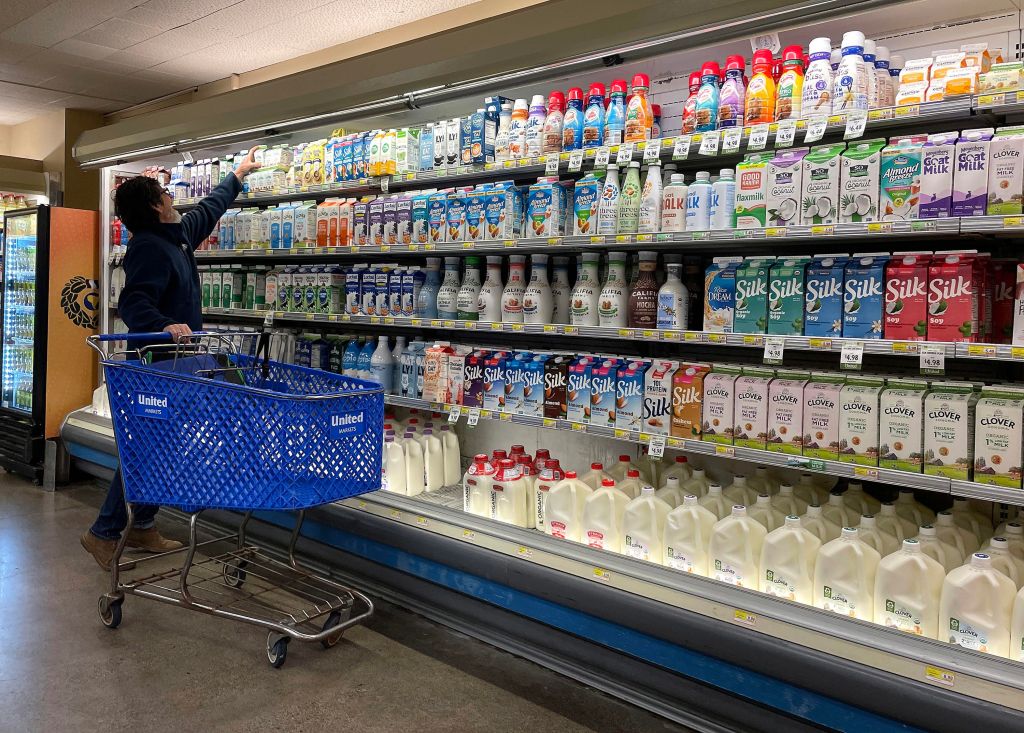Brenda Goodman, CNN
Published on June 26, 2024 at 7:32 AM PDT | Updated on June 26, 2024 at 7:32 AM PDT
A customer buys milk at a grocery store in San Anselmo, California, in December 2023. The FDA says it will further test dairy products that have been removed from grocery store shelves after government health agencies released new research on the potential impact of an H5N1 avian flu outbreak on dairy cows. (Photo by Justin Sullivan/Getty Images via CNN New Source)
(CNN) — US health officials are launching a new round of testing of dairy workers and dairy products to better understand the potential impact of H5N1 avian influenza.
The Centers for Disease Control and Prevention is partnering with Michigan to launch a long-awaited study to determine whether workers who came into contact with infected cows were themselves infected, and the Food and Drug Administration is testing a so-called flash pasteurization method after recent studies raised doubts about whether the method can neutralize all infectious viruses in milk.
The projects are part of a series of new studies announced Tuesday by federal agencies to understand the dynamics of H5N1 avian influenza, which first jumped from birds to dairy cows earlier this year. Since late March, more than 120 cows in 12 states have tested positive for the highly contagious infection, which is believed to be spread through contact with raw milk, the U.S. Department of Agriculture confirmed.
“We know it can be transmitted through contact with milk,” said Dr. Eric Deeble, deputy senior adviser for highly pathogenic avian influenza at the U.S. Department of Agriculture.
Deeble said cattle movement was initially the primary driver of spread, but a recent epidemiological investigation by the Michigan Department of Agriculture and Rural Development (MDARD) found that since the USDA mandated testing of cattle before they were moved from state to state in late April, the infection is now being carried by farms sharing equipment and workers.
“We know that milk has very high viral loads, and when we look at the patterns of transmission it appears there is a very high risk,” said MDARD Director Dr. Tim Bowling.
Bowling said it's not yet clear how the virus uses humans to spread — whether through infection or contaminated clothing or skin.
“My guess is that it's probably not a binary thing, whether it's on the human body or in the human body,” Bowling said.
Dairy farmers are reluctant to allow government officials to enter farms and conduct widespread testing of dairy cows, and farm workers are hesitant to get tested even if they have symptoms, because advocates say they are afraid to get tested because it could mean losing their jobs and their pay.
Michigan announced last week that it would pay up to $28,000 each to 20 dairy farms to participate in the study, a financial boost that is in addition to any federal funding.
The suggestion appears to have worked: On Tuesday, the CDC announced it was partnering with the Michigan Department of Health and Human Services to launch a study to test farmworkers' blood for antibodies to the H5N1 virus.
“The goal of this study is to determine whether there is asymptomatic infection among workers who have contact with cattle infected with the H5N1 virus,” said Dr. Demetres Daskalakis, director of CDC's National Center for Immunization and Respiratory Diseases.
The FDA also announced Tuesday that it has begun sampling dairy products again to make up for findings from previous inspections. The 155 products being recalled from store shelves now include raw milk cheese, cream cheese, ice cream and butter, said Don Prater, acting director of the FDA's Center for Food Safety and Applied Nutrition.
Earlier this year, the FDA's initial testing of milk, sour cream, and other dairy products purchased from grocery stores found traces of the virus in one in five items sampled. But subsequent testing confirmed that these viral fragments were inactive and could not cause illness, so the FDA declared that milk and other dairy products were safe to consume as long as they were pasteurized.
But two recent studies published in the New England Journal of Medicine raise new questions: They found that heating infected raw milk for the times and temperatures used for flash pasteurization (the most common pasteurization method in the United States) significantly reduced levels of infectious virus in the milk, but did not completely neutralize it.
But the scientists cautioned that more research is needed because the experiment was not an exact replica of the flash pasteurization process, which includes a preheating step. Prater said the FDA believes the experiment is close to the methods used in commercial milk processing.
The FDA's to-do list also includes studies to measure the persistence of the virus as cheese ripens, as well as pooled testing of raw milk samples from dairy farms.
Prater did not provide a specific timeline for when officials might have results from those studies, but said he expects information in the near future.
Read more about bird flu:
The-CNN-Wire™ & © 2024 Cable News Network, Inc., a Warner Bros. Discovery Company. All Rights Reserved.
Report a typo
Source link



